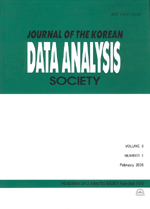Sellke Construction과 동적 생존 함수를 이용한 확률적 감염병 확산 모형 구축
Construction of Stochastic Epidemic Model using Sellke Construction and Dynamic Survival System
- 한국자료분석학회
- Journal of The Korean Data Analysis Society (JKDAS)
- Vol.23 No.2
-
2021.04563 - 575 (13 pages)
-
DOI : 10.37727/jkdas.2021.23.2.563
- 45

Sellke construction은 Kermack과 Mckendrick(1927)이 제안한 SIR 모형을 구축하기 위한 방법으로 감염병의 확산이 확률적 과정을 따른다는 가정한다. 본 연구는 Sellke construction과 동적 생존 함수를 결합하여 감염병의 확산 단계에서 각 개개인의 상태가 감수성군(susceptible)에서 감염군(infected)으로 그리고 감염군에서 회복군(recovered)로 이동하는 것을 생존분석 모형에서 더 이상 생존하지 않고 사망하는 상태가 되는 것으로 적용하여 감염병 확산 모형을 구축하고자 하였다. KhadaBukhsh et al.(2019)은 Survival dynamical system(SDS)을 제안하였는데 본 연구는 기존 연구에서 제안된 모형을 보다 단순화시켜 감염 시간만의 정보를 가지고 있을 때 모형을 구축하는 방법을 제안하였다. 환자 개개인의 마이크로 정보를 이용할 수 있기 때문에 보다 정교한 모형의 구축이 가능하며 모형의 설명력을 높일 수 있다. 제안된 모형으로부터 모수를 추정하기 위하여 MCMC 알고리즘으로부터 사후 표본을 추출하기 위하여 Hamiltonian Monte Carlo(HMC) 방법을 이용하였다. 본 연구에서 제안된 방법은 2015년 우리나라에서 발생하였던 중동호흡기증후군(MERS) 감염병 자료에 적용하여 모수를 추정하고 새로운 감염병 모형을 구축하였다. 모수 추정과 더불어 기초감염재생산수(R₀)을 함께 추정한 후 기존의 여러 연구 방법들에서 추정된 결과와 비교를 진행하였다. 모형의 적합 정도를 평가하기 위하여 실제 관찰된 데이터와 추정된 모형을 비교하여 모형의 적합도가 매우 높은 것을 확인하였다.
Sellke Construction is an alternative method for building a SIR model proposed by Kermack and McKendrick (1927), assuming that the spread of infectious diseases follows a stochastic process. This study combined Sellke Construction and Dynamic Survival System to build an epidemic model by applying the migration of each individual s state from Susceptible to infected status or from Infected to recovered status to death in the survival analysis model. The approached was originally proposed by KhadaBukhshet al. (2020). In this research, we simplified their method utilizing only infection time information. To estimate parameters from the proposed model, the Hamiltonian Monte Carlo (HMC) method was used to draw samples from a posterior distribution in the MCMC algorithm. We applied the proposed method to Middle East Respiratory Syndrome (MERS) infectious disease data that occurred in Korea in 2015. we estimated not also model parameters but also the basic reproduction number (R₀). We compared the estimated results with several previous research results. To evaluate the accuracy of the fitted model, we compared the actual observed data with the estimated model.
1. 서론
2. SDS 모형 구축
3. 자료 분석
4. 결론
References
(0)
(0)